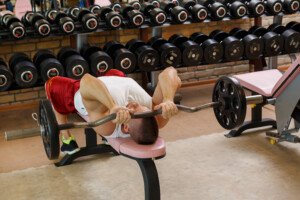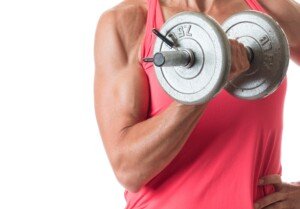
So if isolation work can’t build muscle and only compound moves can, why do big bodybuilders do a lot of isolation exercises?
Isn’t this a contradiction?
You’ve had it drilled into your head by now: If you want to build mass, stay away from isolation work and focus mostly on big compound exercises like the deadlift, back squat, bent-over barbell row, overhead press, bench press, T-bar row, etc.
Yet you’re flummoxed by all those guys at your gym with freaking huge muscles, doing endless isolation work like one-armed cable triceps extensions, overhead triceps extensions, dumbbell side lifts, front lifts, posterior lifts, plus all those biceps curls…
Why do bodybuilders do a lot of isolation work rather than mostly compound “mass building” moves?
“Isolation work isn’t pointless; it has its place in an exercise program, if used correctly,” says Phil Sims, a personal trainer and online coach with Phil Sims Personal Training.
“The typical fit pro may well criticize those who use isolation methods for a few reasons, one of those being that you can get a bigger bang for your buck using compound moves like deadlifts, chins and dips.
“Compound moves will of course produce the biggest energy expenditure, meaning more calories have been burnt.
“This is great for the typical person on the street who has limited time and just wants to lose weight.”
And in fact, when fitness experts and personal trainers slam isolation moves, it’s almost always because they have fat loss in mind for their clients and prospective clients—maximal fat loss.
The vast majority of personal-training clients want to lose weight, and many sign up for twice-weekly sessions.
So yes, the biggest bang for your buck is in order, and hence, isolation work has been vilified as a means to fat loss, especially when one has limited time.
How much weight can you lose doing only biceps curls, triceps press-downs and lateral raises, vs. trading those in for three giant compound moves: back squat, deadlift and bench press?
And while the compound moves will shear off the fat, they will also do a fabulous job of reshaping the physique, of producing (with proper diet) a great swimsuit body.
But most clients are not trying to be bodybuilders who are gunning for the biggest mass gains possible.
They just want that killer beach body; maximum hypertrophy is not on their menu.
Another Benefit of Isolation Work
“Isolation exercises also have a place for those coming back from injury,” says Sims.
“An isolation exercise with its single-joint action can help you work around any issue you may have until fully repaired.”
But what about bodybuilders doing tons of isolation work?
Why don’t we see the biggest guys in the gym all hanging at the squat rack or pounding out the deadlifts?
Well, we DO see huge guys at the bench press station, but seems as though the faithful squatters and deadlifters aren’t usually the best candidates for a bodybuilding contest.
“Now for the bodybuilders, isolation exercises are a bodybuilder’s best friend,” says Sims.
“Compound moves provide the overall strength, but people will tire very quickly.
“A bodybuilder wanting to produce size will need to have a much greater volume approach.
“This is where isolations can come into place. The more volume and greater fiber recruitment, the bigger the muscle can repair and grow back.

Shuttersock/Nicholas Piccillo
“That’s why you’ll see people starting with the bigger exercises and finishing a workout with the smaller isolations like curls, etc.
“Typically these types of workouts will use supersets, post-exhaust and pre-exhaust.
“Combining both compounds and isolations will give the serious bodybuilder a combination of strength and size gains.”
 Phil Sims
Phil Sims
 Lorra Garrick is a former personal trainer certified by the American Council on Exercise. At Bally Total Fitness she trained clients of all ages for fat loss, muscle building, fitness and improved health.
Lorra Garrick is a former personal trainer certified by the American Council on Exercise. At Bally Total Fitness she trained clients of all ages for fat loss, muscle building, fitness and improved health.
.











